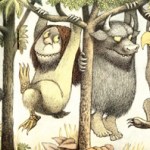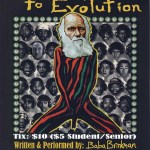evolution
tags: What, If Anything, Is Big Bird?, taxonomy, taxonomy, evolution, Grandicrocavis, Big Bird, flightless birds, ratites, humor, comedy, science humor, dinosaur humor, Mike Dickison, PechaKucha, Christchurch, streaming video
Years ago, when Zoologist Mike Dickison was in the early stages of his PhD, he gave a joke presentation at a graduate student conference on the taxonomy and evolution of a giant flightless bird. It was the sort of thing you'd see at any conference on avian evolution: a Latin name, reconstructed skeleton, possible place on the great evolutionary tree of birds. The tone…
tags: vultures, Gyps species, conservation biology, endangered species, veterinary medicine, toxicology, physiology, evolutionary biology, pharmaceutical chemistry, epidemiology, mathematical modeling, researchblogging.org,peer-reviewed research, journal club
Only thirty years ago, tens of millions of White-rumped Vultures, Gyps bengalensis,
were flying the skies of Asia. They are now classified as Critically Endangered.
Image: Marek Jobda / rarebirdsyearbook.com [larger view]
A zombie is another name for The Walking Dead -- those who are lifeless, apathetic, or totally lacking in…
As I highlighted in my previous post, evolution works on zombies just like any other organism, the main difference is that they reproduce like cells rather than like animals. Darwin's discovery that zombies pass on hereditary material in their bites, and that this has resulted in natural selection, helps to explain the diversity of zombies now before us. Below are a few of the main strategies that an evolutionary understanding can bring to counter the marauding hordes of decomposing evil that now threaten to overwhelm us.
#1 - Don't get bitten. Okay, this is a no-brainer (pun intended).…
Credit: Revenant Magazine
The origin of zombies (Genus: Zumbi) is well understood today, but this wasn't the case when they were first discovered in the early 1800s. Charles Darwin was the first to recognize that zombie "reproduction" results in a process of descent with modification in a way analogous to that of non-undead species. Darwin's insight was that, even though zombie's don't reproduce sexually, random mutations in hereditary material can be passed along after a zombie bite. Each "daughter zombie" then inherits the traits of their parent and pass those traits along to their…
tags: birds, ornithology, Common Raven, Northern Raven, Corvus corax, animal behavior, animal culture, aggression, dominance hierarchy, social groups, social conflict, post-conflict behavior, consolation, empathy, researchblogging.org,peer-reviewed research, journal club
Common Raven, Corvus corax, showing off at Bryce Canyon National Park, USA.
Image: United States National Park Service (Public Domain) [larger view]
Humans have long tried to distinguish themselves from other animals on the basis of characters that are perceived to be unique, such as tool design and use, planning for the…
Who remembers Robert Ardrey? I must shamefully confess that I was a fan back in the 1970s, when the 'killer ape' hypothesis was in the air. This was the idea that one of the things that made humans different and drove the evolution of the human brain was aggression and competition, specifically that big brains evolved as a weapon in a multi-million year intra-specific arms race. Arms races are cool concepts that, when first introduced to natural selection, seem like powerful mechanisms to drive the evolution of elaborate features.
I outgrew Ardrey, have no fear. As I learned more biology, I…
Author's Note: The following is an excerpt from my review of Sex At Dawn: The Prehistoric Origins of Modern Sexuality. For additional information see my posts Reexamining Ardipithecus ramidus in Light of Human Origins, Those Cheating Testicles, or Who's Your Baby? as well as Helen's Lament and the Origins of Forbidden Love. Christopher Ryan also blogs at Psychology Today.
When we think of the first swinger parties most of us imagine 1970s counter-culture, we don't picture Top Gun fighter pilots in World War II. Yet, according to researchers Joan and Dwight Dixon, it was on military bases…
tags: Of Venom and Silk, arachnids, spiders, new species, endangered species, NYC, New York City, AMNH, American Museum of Natural History, streaming video
Spider biologist Norman Platnick, from the American Museum of Natural History, has traveled the world cataloguing some of these creatures, many for the first time ever. World renowned for his work, he hopes to find as many as species as possible before some disappear.
The skeleton of the Hundsheim rhinoceros, Stephanorhinus hundsheimensis. From Kahlke and Kaiser, 2010.
In any given environment, it might be expected that a generalized or unspecialized species might be less prone to extinction than one which depends upon a narrow temperature range, a peculiar kind of food, or other aspect of natural history which is key to its survival. An herbivorous mammal which can subsist on a variety of grasses, leaves, and other plant foods, for example, may be more likely to survive an ecological disruption than a species tied to foliage which might die back during…
tags: Evolution in Action by AMNH, Congo River, fishes, AMNH, American Museum of Natural History, evolution, variation, biodiversity, Melanie Stiassny, streaming video
This video tells the story of speciation in Central Africa's roiling, rapid Lower Congo River. This river is home to an extraordinary assortment of fish -- many truly bizarre. This new video by Science Bulletins, the American Museum of Natural History's current-science video program, features Museum scientists on a quest to understand why so many species have evolved here. Follow Curator of Ichthyology Melanie Stiassny and her…
tags: Birdbooker Report, bird books, animal books, natural history books, ecology books
Books to the ceiling,
Books to the sky,
My pile of books is a mile high.
How I love them! How I need them!
I'll have a long beard by the time I read them.
~ Arnold Lobel [1933-1987] author of many popular children's books.
The Birdbooker Report is a special weekly report of a wide variety of science, nature, environment and behavior books and field guides that currently are, or soon will be available for purchase. This report is written by one of my Seattle birding pals and book collector, Ian "…
tags: Inside the Collections: Ichthyology at AMNH, fishes, AMNH, American Museum of Natural History, evolution, variation, biodiversity, Melanie Stiassny, streaming video
This video is the first of a new series of behind-the-scenes looks at the collections at the American Museum of Natural History. In this video, Melanie Stiassny, Axelrod Research Curator in the Department of Ichthyology, takes us through the Museum's vast collection of fishes.
The Department of Ichthyology, one of the four departments within the Museum's Division of Vertebrate Zoology, houses a collection that comprises more…
tags: evolution, biogeography, phylogeography, animals, Here Be Dragons, How the Study of Animal and Plant Distributions Revolutionized Our Views of Life and Earth, Dennis McCarthy, book review
I'm happy: another book review of mine was just published, this time, by Science magazine. This book, Here Be Dragons: How the Study of Animal and Plant Distributions Revolutionized Our Views of Life and Earth (Oxford University Press: Oxford; 2009), is by Dennis McCarthy, a researcher at the Buffalo Museum of Science in Buffalo, New York. In short, I liked the book and I thought it was generally well-…
There is not really a good way to get rid of the junk in your genome. Pretty much, once its in there, its in there-- there is no organized biochemical system that says "Oy! This 'eres crap!" and cuts out the useless bits, cleaning up residual transposable elements like a chimney sweep. We just keep accumulating this stuff.
An exception to this is recombination.
Your chromosomes dont always line up just perfectly during meiosis, so when you have lots of repetitive elements (junk DNA-- transposable elements, ERVs, etc), you can 'accidentally' cut out (or duplicate!) parts of your genome.…
The skeletons of Lucy (left) and Kadanuumuu (right). Both belong to the early human species Australopithecus afarensis. (Images not to scale.)
I never fully appreciated how small Lucy was until I saw her bones for myself. Photographs and restorations of her and her kin within the species Australopithecus afarensis had never really given me a proper sense of scale, and when I looked over her incomplete skeleton - formally known as specimen A.L. 288-1 - I was struck by her diminutive proportions. In life she would have only been about three and a half feet tall. Her physical stature seemed…
tags: The Laryngeal Nerve of the Giraffe is Proof of Natural Selection, animals, giraffe, evolution, creationism, intelligent design, dissection, necropsy, autopsy, recurrent laryngeal nerve pathway, vagus nerve, cranial nerve X, evolutionary legacy, Richard Dawkins, streaming video
This video, including comments by Richard Dawkins, documents a necropsy (an autopsy on an animal other than a human) carried out in a classroom on a giraffe. In this video, we follow the pathway of the recurrent (inferior) laryngeal nerve, an important nerve that is a branch of the Vagus nerve (tenth cranial nerve…
tags: Birdbooker Report, bird books, animal books, natural history books, ecology books
Books to the ceiling,
Books to the sky,
My pile of books is a mile high.
How I love them! How I need them!
I'll have a long beard by the time I read them.
~ Arnold Lobel [1933-1987] author of many popular children's books.
The Birdbooker Report is a special weekly report of a wide variety of science, nature, environment and behavior books and field guides that currently are, or soon will be available for purchase. This report is written by one of my Seattle birding pals and book collector, Ian "…
I use a very pretty radial tree of life diagram fairly often — the last time was in my talk on Friday — and every time I do, people ask where I got it. Here it is: it's from the David Hillis lab, with this description:
This file can be printed as a wall poster. Printing at least 54" wide is recommended.
(If you would prefer a simplified version with common names, please see below.)
Blueprint shops and other places with large format printers can print this file for you.
You are welcome to use it for non-commercial educational purposes.
Please cite the source as David M. Hillis, Derrick Zwickl…
Last week's spat between Nicholas Carr and Steven Pinker generated a lot of attention â and, happily, delivered a couple of the more lucid framings yet of the debate over whether digital culture makes us shallow, as Carr argues in his new book, or simply represents yet another sometimes-distracting element that we can learn to deal with, as Pinker countered in a Times Op-Ed last Thursday.
Â
I sympathize with both arguments; I see Carr's point but feel he overplays it. I find digital culture immensely distracting. I regularly dive down rabbit holes in my computer,…
When most people think of evolutionary biology the first thing that comes to mind probably isn't lyrical poetry. However one of the earliest proponents of evolution, none other than Charles Darwin's grandfather Erasmus, presented his vision for the origin of life in the form of an epic poem in 1803. In his critically acclaimed work The Temple of Nature Darwin mused on the natural history of human beings:
Imperious man, who rules the bestial crowd,
Of language, reason, and reflection proud,
With brow erect who scorns this earthly sod,
And styles himself the image of his God;
Arose from…



